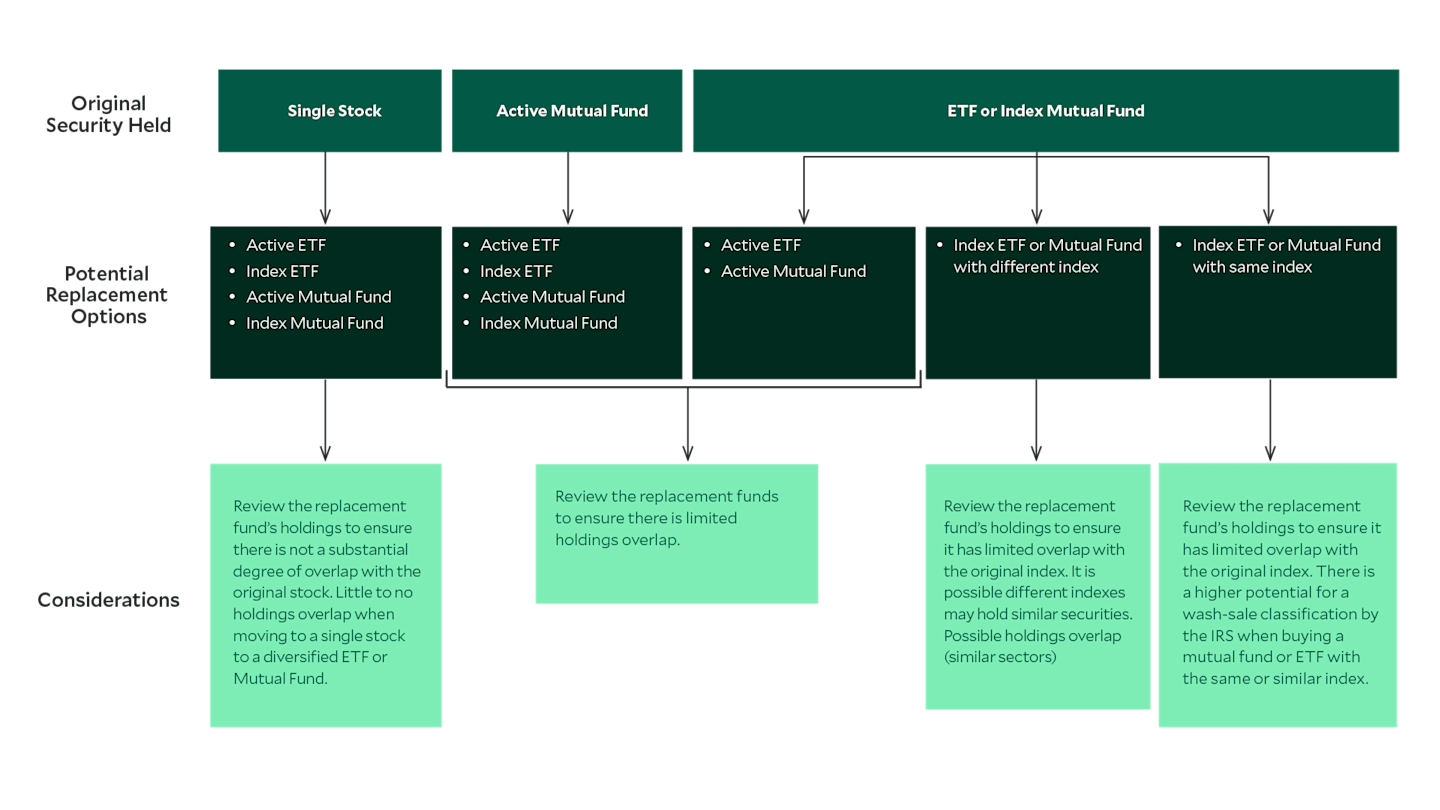Manage Taxes with Loss Harvesting and ETFs

We all get satisfaction when we make money on the sale of a stock, yet these gains can come with the surprise of hefty tax bills. Losses, on the other hand, can be hard to swallow. The good news is that losses may come with a silver lining in the form of potential tax benefits.
“Tax-loss harvesting,” as it is known, allows investors to offset gains realized in one investment with losses incurred in another.* The following hypothetical example illustrates how this technique can help reduce an investor’s tax liability.
Tax-Loss Harvesting: A Hypothetical Example

- The hypothetical long-term loss from the sale of XYZ partially offsets the long-term gain from the sale of ABC.
- This example assumes a capital gains tax rate of 15 percent. This rate varies by filing status and income.
- The offsetting loss results in a tax savings of $600.
Some Dos and Don'ts of Tax-Loss Harvesting
Following a few general guidelines could help you take advantage of this opportunity and may help avoid running afoul of the IRS’s wash sale rule. Remember everyone’s situations is different. Please consult a tax advisor for your individual situation. Continue reading to learn more about this rule.
Do | Don't |
|---|---|
Use the strategy for taxable accounts only, as there is no tax benefit to harvesting losses in a tax-deferred account Replace a security sold for a loss with another similar (but not substantially identical) security in order to maintain desired exposure | Limit tax-loss harvesting to the end of a calendar year. Opportunities may present themselves throughout the year as markets fluctuate and flexibility may improve outcomes |
Consider the relative advantages and disadvantages of using ETFs, active mutual funds, or indexed mutual funds to replace a security sold for a loss | Sell a security for a loss from a taxable account and then repurchase it within 30 days in a tax-deferred account |
If losses exceed gains in any one year, carry over any unused losses to apply against gains in future years | Let taxes alone drive investment decisions – the decision to harvest losses should be made in concert with the overall investment plan |
NOTE: Specific security types, such as municipal bonds, may be subject to additional rules. Please consult your tax advisor.
Time to Review
Reviewing each portfolio’s capital gains tax exposure is an important component in your holistic approach to financial planning.
Following is an overview of some recent changes in tax law that you should keep in mind in tax planning:
One Big Beautiful Bill (OBBB)
In July of 2025, One Big Beautiful Bill was signed into law and for many taxpayers, this will prevent tax increases that would have occurred if the Tax Cut Job Act (TCJA) of 2017 had expired in December of 2025.
The Long and Short of It
There’s a significant tax advantage to holding onto assets for longer than a year, since long-term cap gains tax rates (0%, 15%, 20%) are much lower than short-term cap gains tax rates (taxed as ordinary income).
Qualified dividends are taxed at the long-term capital gains rate and ordinary dividends and income paid on bonds is taxed at the standard federal income tax rates.
If losses exceed gains in a given year, they can be carried forward until gains are depleted.
Investors may also deduct up to $3,000 in losses from their income each year.
Taxes apply on gains from the sale of a residence (net of improvements and exclusions), yet losses on their sale cannot be deducted.
Tax Year 2025
The Internal Revenue Service announced the tax year 2025 annual inflation adjustments for more than 60 tax provisions for 2025, including the tax rate schedules and other tax changes. Revenue Procedure 2024-40 provides details about these annual adjustments.
The IRS has expanded the standard deductions for tax year 2025 that will generally apply to income tax returns filed in 2026. For more details on the IRS tax inflation adjustments for 2025, please consult your tax advisor.
Watch Out for Wash Sales
The IRS’s wash sale rule is designed to keep investors from claiming artificial losses, so it’s critical to understand it if you’re planning to harvest losses.
The rule prohibits the sale of a security in order to claim a loss if the investor repurchases it—or a “substantially identical” security—within 30 days before or after the sale. Violating this rule could negate any potential tax benefits from the transaction.
How does the IRS define “substantially identical” security? Unfortunately, they have not identified specific criteria.** Nevertheless, to determine the potential for a wash sale violation, there are some factors that investors may want to consider, including the degree of holdings overlap and the difference in prospective returns. The greater the holdings overlap and the more similar the prospective returns, the greater the possibility of a wash sale classification by the IRS.
Many investors consider Exchange Traded Funds (ETFs) as well as active and indexed mutual funds as effective tools to gain desired portfolio exposures. Yet it’s important to exercise caution to avoid violating the wash sale rule. The following framework provides an overview of the extent to which ETFs, active mutual funds, and index mutual funds may feature low portfolio overlap as well as differences in prospective returns under various scenarios.
Considerations for Tax-Loss Harvesting

Note: You should consider the replacement fund’s investment objectives, risks and charges and expenses carefully before you invest.
Tax-Loss Harvesting Do's and Don'ts
Use our framework as a starting point for year-end tax planning discussions.
Long- and short-term capital gains are taxed at different rates. Long-term gains may only be offset by longer-term losses. Likewise, short-term gains may only be offset by short-term losses.
As of April 30, 2024, the Internal Revenue Service has not released a definitive opinion regarding the definition of “substantially identical” securities and its application to the wash sale rule and ETFs. The information and examples provided are not intended to be a complete analysis of every material fact and are presented for educational and illustrative purposes only. Tax consequences will vary by individual taxpayer and individuals must carefully evaluate their tax position before engaging in any tax strategy.
IRS Circular 230 Disclosure: American Century Companies, Inc. and its affiliates do not provide tax advice. Accordingly, any discussion of U.S. tax matters contained herein (including any attachments) is not intended or written to be used, and cannot be used, in connection with the promotion, marketing or recommendation by anyone unaffiliated with American Century Companies, Inc. of any of the matters addressed herein or for the purpose of avoiding U.S. tax-related penalties.
This information is for educational purposes only and is not intended as tax advice. Please consult your tax advisor for more detailed information or for advice regarding your individual situation.
Exchange Traded Funds (ETFs) are bought and sold through exchange trading at market price (not NAV), and are not individually redeemed from the fund. Shares may trade at a premium or discount to their NAV in the secondary market. Brokerage commissions will reduce returns.
Investment return and principal value of security investments will fluctuate. The value at the time of redemption may be more or less than the original cost. Past performance is no guarantee of future results.